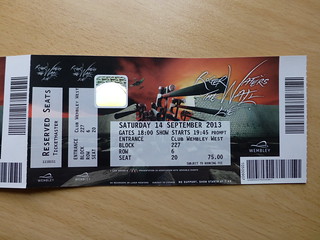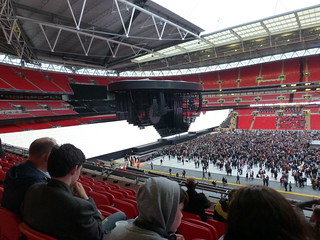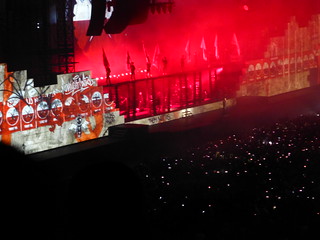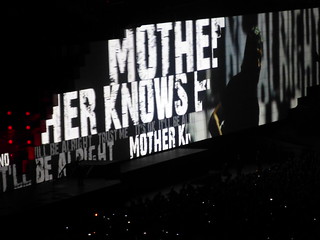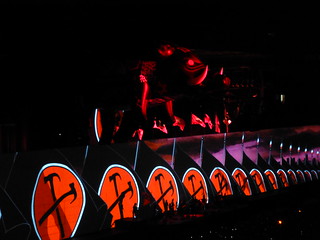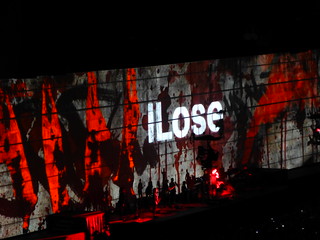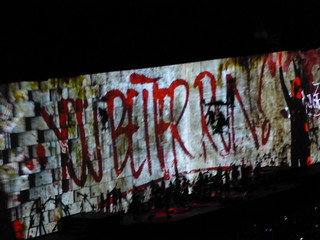After the introductory chapters the first half of the book proper is a chronological look at the politics & wars of the time period. This chapter covers 40 years of Henry III’s reign, from when he started to exert his own authority in 1225 through to the final end of the rebellion against him with the death of Simon de Montfort in battle in 1265.
Orientation Dates:
- Henry III reigns 1216-1272.
- Saint Louis IX (builder of Sainte-Chapelle) ruled France 1226-1270.
- Genghis Khan died in 1227.
- Edward I born 1239.
Politics Under Henry III
The thread that ties this chapter together is that the politics of the day was very much grounded in the personalities of the players. The interactions between & the fallings out of the aristocracy shaped the government of the country. And Henry III was not a strong enough king to pull it all together – Prestwich describes Henry III as a man who could talk the talk, but not walk the walk. He had strong ideas about the authority & power that king should command, but when faced with opposition he tended to back off. He successively fell under the influence of different groups at court – often foreign relatives of himself or his wife – which didn’t help relations with other factions, particularly English ones. So his reign was a turbulent time politically speaking, even before the conflict with de Montfort.
He’d become king at the age of 9 (in 1216) while England was in the middle of a civil war, with the eldest son of the King of France (Louis, son of Philip II) in control of the south-east of the country. His initial regents(? Prestwich doesn’t use the term, so perhaps that’s an anachronism on my part) got the country back under control and over the rest of Henry III’s minority Plantagenet authority was restored. But factionalism was still rife. The next twenty or so years after Henry started to exert authority on his own behalf (in 1227) were characterised by a stumbling from crisis to crisis, with the king failing to prevent the bickering & factional infighting. At times it veered close to civil war but mostly the situation pulled back from the brink before armies met (with an exception being the Welsh Marches in 1234, where battles were fought).
Finance & taxation began to become an issue. At this time to raise a tax the king had to have the consent of the aristocracy. During this period Parliament came to prominence as the way to gain this consent, and it’s in Henry’s reign that the term “parliament” was first used. The king had to persuade them that he was going to spend the money in a useful & profitable fashion for the country. Parliament could and did say no to requests for taxes, or could agree only after imposing conditions on the king (for instance to re-affirm the Magna Carta). In 1244 Henry III tried to negotiate a tax, but failed to come to an agreement with Parliament. He wasn’t to succeed in any further requests either, so had to resort to other ways to raise money. These included increasing the amounts that sheriffs paid for their counties, and tax on Jews (this could be done without an agreement) – these sorts of measures weren’t sustainable in the long term.
Foreigners at court were a perennial complaint, but became a more significant issue from the 1240s onwards. Prestwich notes that most of the information here comes from a single chronicler who was rather xenophobic, but there are indications it was a wider spread issue than just one man’s prejudices. One group of foreigners were Henry’s wife Eleanor of Provence’s relatives, the Savoyards – when he married her in 1236 she brought members of her family & various retainers to court. Henry was generous to them & gave them jobs, lands, marriages & so on. Some like Eleanor’s uncle William of Savoy were particularly useful to him & helped reform government of the country, but that didn’t help make them any more popular. Another group of foreigners to get patronage were the Poitevins, related to Henry via his mother’s second marriage – this included his four half-brothers. The numbers of foreigners in these groups were not small. There were approximately 170 men with Savoyard connections to get patronage from Henry, and about 100 Poitevins. Adding to the turbulent politics was the fact that the Savoyards & Poitevins saw each other as rivals.
The third “group” of foreigners is a single man – Simon de Montfort. Not part of either the Savoyard or Poitevins, he came from the Ile de France and his family had a claim via marriage to the earldom of Leicester which he came to England to claim in 1230. He soon charmed his way into the inner circle of the court, he even married the king’s sister in 1238 (clandestinely, and this sparked a political crisis with him & the king on the same side for now). Henry & Simon started to fall out over money as early as 1239, but reconciled. In the early 1250s Simon’s rule over Gascony (as Henry’s lieutenant) had started to attract protest over its harshness. He was even brought back to England and put on trial in 1252 (a case that Prestwich says he “did not lose”). Even after this he & Henry reconciled once more.
Prestwich takes a short digression at this point in the story of the period to discuss the Church & how it played into the political situation in the late 1250s. During approximately the same time that Henry had been on the throne of England there was a gathering enthusiasm for reform within the Church. The new emphasis was on pastoral care & included measures such as clerics only holding one benefice each and not behaving in unseemly ways. The various orders of friars start up in this period – the Dominicans and Franciscans both reach England in the 1220s. And this enthusiasm for reform spilled over into the secular politics of the day – that the king should be subject to the law, that he should choose his councillors wisely, that his officials had an obligation to act fairly.
And now we’re at the build up to the civil war that ended with Simon de Montfort’s death. By 1258 Henry’s government was seen as incompetent & the Parliament that met in Oxford that year took steps to Do Something About It. They set out a complex scheme for picking a fair council of 15 that would evenly represent both king & barons, and this council would be where the final authority rested rather than with the king. At first it worked, and investigations were set up into all areas of administration with an aim to reforming them to make the rule of the country more fair and just (notably this extended significantly down the social strata, including grievances to be righted that would favour ordinary freemen). But progress was too slow for many on the baronial side, and personalities were still important – Prestwich says that de Montfort was not good at collaboration, or compromise, which meant that rifts opened in the baronial ranks. The initiative started to move to the king’s side, and by 1261 he’d managed to regain control to the extent that he could dismiss the council & put his own men in positions of power. Some of the barons had come over to his side, and Henry started to try & patch up his private quarrels with Simon de Montfort in hopes of neutralising him (which didn’t work).
But finance was still a problem – Henry still could not gather taxes. He also failed again to establish any sort of stable regime. Simon de Montfort returned to England in 1263 determined to force the king to accept the reforms propsed in 1258. There was some violence in early 1263 that lead to a series of negotiations in the second half of the year, under the arbitration of the King of France. At first Louis favoured de Montfort – Louis approved the Provisions of Oxford that had been laid out in 1258 & demanded the restitution of property to those who’d suffered in the violence in 1263. The opposition of the future Edward I was a particular problem for this negotiated peace, and a further round of negotiations was required. Louis had now changed his mind – Prestwich says that Queen Eleanor’s influence was a major factor in this – and he was firmly on the royalist side. These negotiations got nowhere & proper civil war broke out in spring 1264.
The advantage at first lay with the king. Henry had summoned a traditional feudal army, ostensibly to fight the Welsh but everyone knew de Montfort & his supporters were the true target. De Montfort’s support was centred on the Midlands (which he ruled a lot of as the Earl of Leicester) and in towns (including London). Henry’s army won the first few battles, including a triumph at Northampton that included the capture of one of de Montfort’s sons. But de Montfort’s supporters felt themselves to be cursaders and went into battle wearing crosses, feeling that God was on their side. This moral zeal and a combination of poor tactics from Edward & good tactics from de Montfort lead to a decisive victory for the baronial cause at Lewes. Victory wasn’t total – they didn’t capture the king or his son, but they did pen them up in Lewes priory from where they negotiated a peace settlement that included Edward remaining in custody as a hostage.
Simon de Montfort was now in charge of the government of the country, and although the king was still king he had no say in anything that happened. The council that was set up was a lot less complex than the previous experiment in 1258, and this let de Montfort exert a great deal of control over who was on it & the decisions it made. Prestwich says that actual reform was thin on the ground, de Montfort spent more time pursuing his personal gain. Despite this he had widespread support. Unfortunately where he started losing support was in the upper echelons of society & that was crucial. The escape of Edward from custody in May 1265, and his subsequent joining of forces with barons who were disaffected with de Montfort lead to the outbreak of further civil war. This time the baronial cause didn’t feel so much that God was on their side – and the royalist cause wore crosses too. Edward & his allies were the winners of the battles, and on 4 August 1265 Simon de Montfort was slain on the field of battle. Some resistance to the royalists rumbled on for another year or so, but the back was broken of the rebellion.
Prestwich rounds off the chapter by concluding that even though the royalist cause were the winners the attempts to reform the government of England were not ignored. The civil war had been short but bitter, and the government of the country needed rebuilt afterwards. There was no longer any talk of restricting the king’s authority, but the reforms were not all tossed out. The next chapter of the book will cover the next 30 years, including the rebuilding process.
A thought I had while reading this was to wonder if there’s ever been a successful English king who took the throne as a minor. The ones that spring to my mind are Henry III (not terribly competent, as discussed here), Richard II (overly autocratic once he came to power, subsequently deposed), Henry VI (turned out to be very incompetent and had mental health issues, deposed twice during Wars of the Roses). Edward VI died too young to know how he’d’ve turned out if he’d reached his majority. Have I forgotten someone?
Another thought is that it’s interesting that Henry III was never deposed, nor even in danger of it. He might’ve had his authority restricted to the point where he wasn’t really ruling any more, but de Montfort didn’t set himself up as king or try & put anyone else on the throne. Particularly interesting in light of Edward II being deposed, as that’s only two generations later.
Tangents to follow up on: The obvious ones really – biography of Simon de Montfort & of Henry III.
